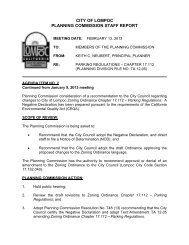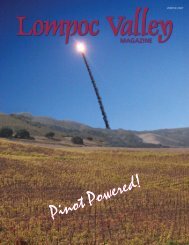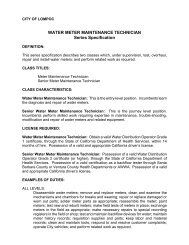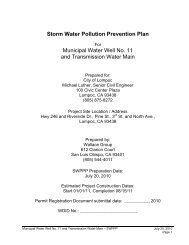Noise and Air Quality - the City of Lompoc!
Noise and Air Quality - the City of Lompoc!
Noise and Air Quality - the City of Lompoc!
- No tags were found...
You also want an ePaper? Increase the reach of your titles
YUMPU automatically turns print PDFs into web optimized ePapers that Google loves.
<strong>City</strong> <strong>of</strong> <strong>Lompoc</strong> General Plan UpdateIssue Paper on <strong>Noise</strong> <strong>and</strong> <strong>Air</strong> <strong>Quality</strong> IssuesGlobal Climate Change. Global climate change (GCC) refers to a change in <strong>the</strong> averagewea<strong>the</strong>r <strong>of</strong> <strong>the</strong> earth which can be measured by wind patterns, storms, precipitation, <strong>and</strong>temperature. The impact <strong>of</strong> anthropogenic activities on GCC is evident in <strong>the</strong> scientificcorrelation between rising global temperatures, atmospheric concentrations <strong>of</strong> CO 2 <strong>and</strong> o<strong>the</strong>rgreenhouse gases (GHGs), <strong>and</strong> <strong>the</strong> industrial revolution 1 .The greenhouse effect is a natural process by which some <strong>of</strong> <strong>the</strong> radiant heat from <strong>the</strong> sun iscaptured in <strong>the</strong> lower atmosphere <strong>of</strong> <strong>the</strong> earth. The gases that help capture <strong>the</strong> heat are calledGHGs. While GHGs are not normally considered air pollutants, all have been identified asforcing <strong>the</strong> earth’s atmosphere <strong>and</strong> oceans to warm above naturally occurring temperatures.Some GHGs occur naturally in <strong>the</strong> atmosphere, while o<strong>the</strong>rs result from human activities.Naturally occurring GHGs include water vapor, carbon dioxide, methane, nitrous oxide <strong>and</strong>ozone. Certain human activities add to <strong>the</strong> levels <strong>of</strong> most <strong>of</strong> <strong>the</strong>se naturally occurring gases.Of all <strong>the</strong> greenhouse gases in <strong>the</strong> atmosphere, water vapor is <strong>the</strong> most abundant <strong>and</strong> variable.The main source <strong>of</strong> water vapor is evaporation from <strong>the</strong> oceans (approximately 85%). O<strong>the</strong>rsources include evaporation from o<strong>the</strong>r water bodies, sublimation (change from solid to gas)from ice <strong>and</strong> snow, <strong>and</strong> transpiration from plant leaves. The primary human-related source <strong>of</strong>water vapor comes from fuel combustion in motor vehicles. However, this is believed tocontribute a negligible amount (less than 1%) to atmospheric concentrations <strong>of</strong> water vapor. Asa result, <strong>the</strong> control <strong>and</strong> reduction <strong>of</strong> water vapor emissions is not within reach <strong>of</strong> humanactions, <strong>and</strong> is <strong>the</strong>refore excluded from regulation under California law.The second most prevalent GHG is carbon dioxide (CO 2 ). Natural sources <strong>of</strong> CO 2 include:decomposition <strong>of</strong> dead organic matter; respiration <strong>of</strong> bacteria, plants, animals, <strong>and</strong> fungus;evaporation from oceans; <strong>and</strong> volcanic outgassing. However, in contrast to water vapor, CO 2 isprimarily generated by anthropogenic (human caused) sources, including burning coal, oil,natural gas <strong>and</strong> wood.After CO 2, <strong>the</strong> GHGs over which humans have <strong>the</strong> greatest control are methane (CH 4 ) <strong>and</strong>nitrous oxide (N 2 O). CH 4 is a flammable gas <strong>and</strong> is <strong>the</strong> main component <strong>of</strong> natural gas. Naturalsources <strong>of</strong> CH 4 include anaerobic decay <strong>of</strong> organic matter <strong>and</strong> natural gas fields; anthropogenicsources include l<strong>and</strong>fills, fermentation <strong>of</strong> manure, <strong>and</strong> cattle. N 2 O is produced by microbialprocesses in soils <strong>and</strong> water, including those reactions which occur in fertilizer containingnitrogen. Anthropogenic sources <strong>of</strong> N 2 O include agricultural soil management, animal manuremanagement, sewage treatment, <strong>and</strong> mobile <strong>and</strong> stationary combustion <strong>of</strong> fossil fuel. Reducingemissions from CO 2, CH 4 <strong>and</strong> N 2 O is <strong>the</strong> focus <strong>of</strong> state GHG regulations.In June 2005, Governor Schwarzenegger signed Executive Order S-3-05, acknowledging <strong>the</strong>environmental impacts <strong>of</strong> greenhouse gas emissions on climate change. The Executive Orderestablished <strong>the</strong> following climate change emission reduction targets for California:1 Intergovernmental Panel on Climate Change (IPCC). Climate Change 2001: The Scientific Basis.Cambridge University Press, 2001.4<strong>City</strong> <strong>of</strong> <strong>Lompoc</strong>
















